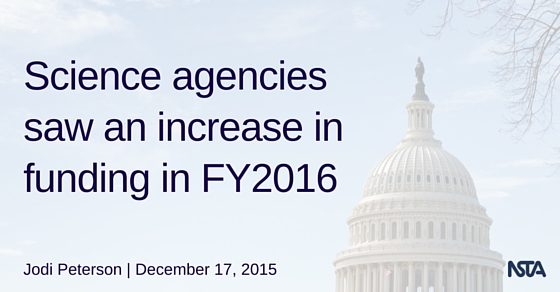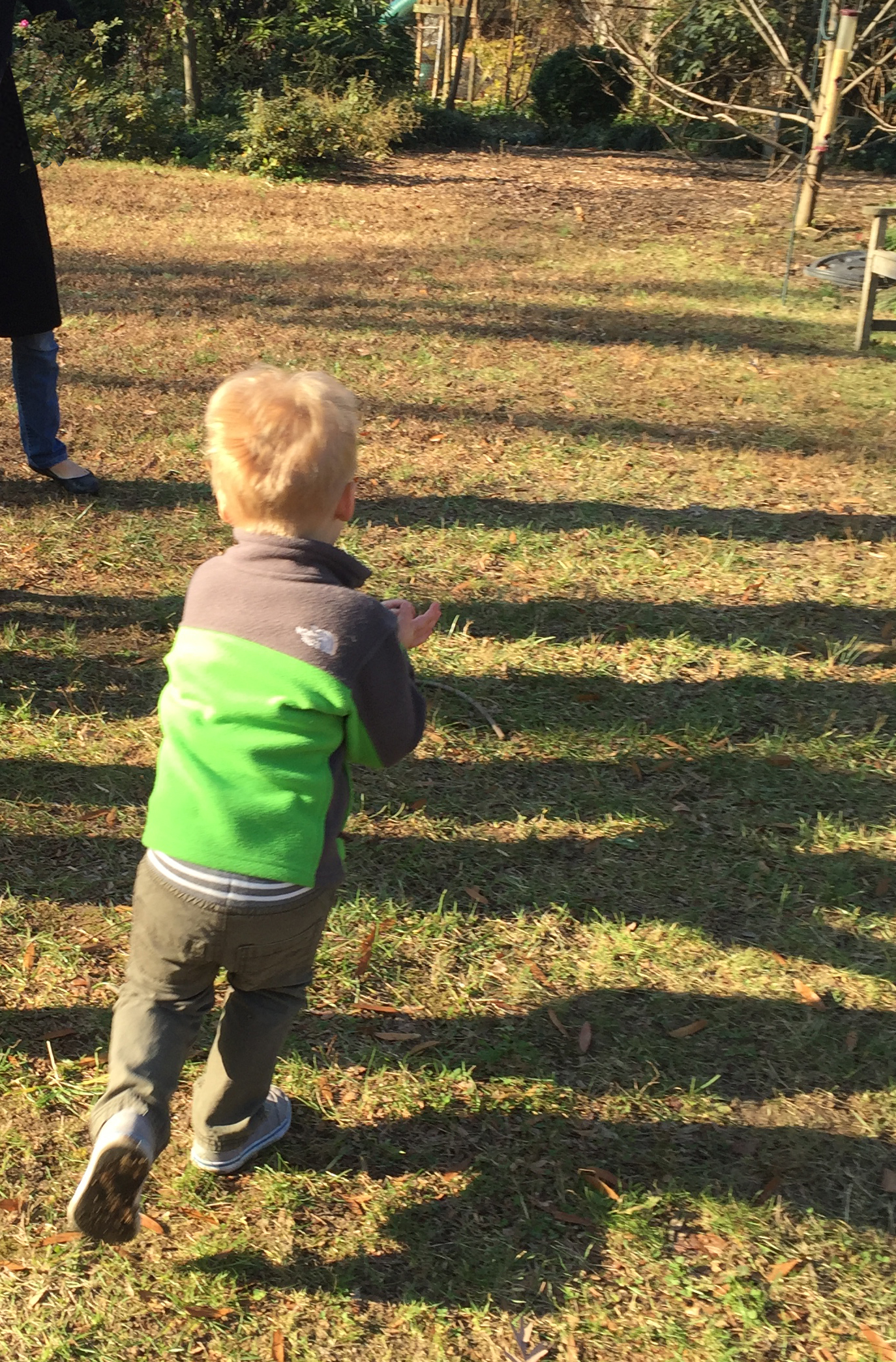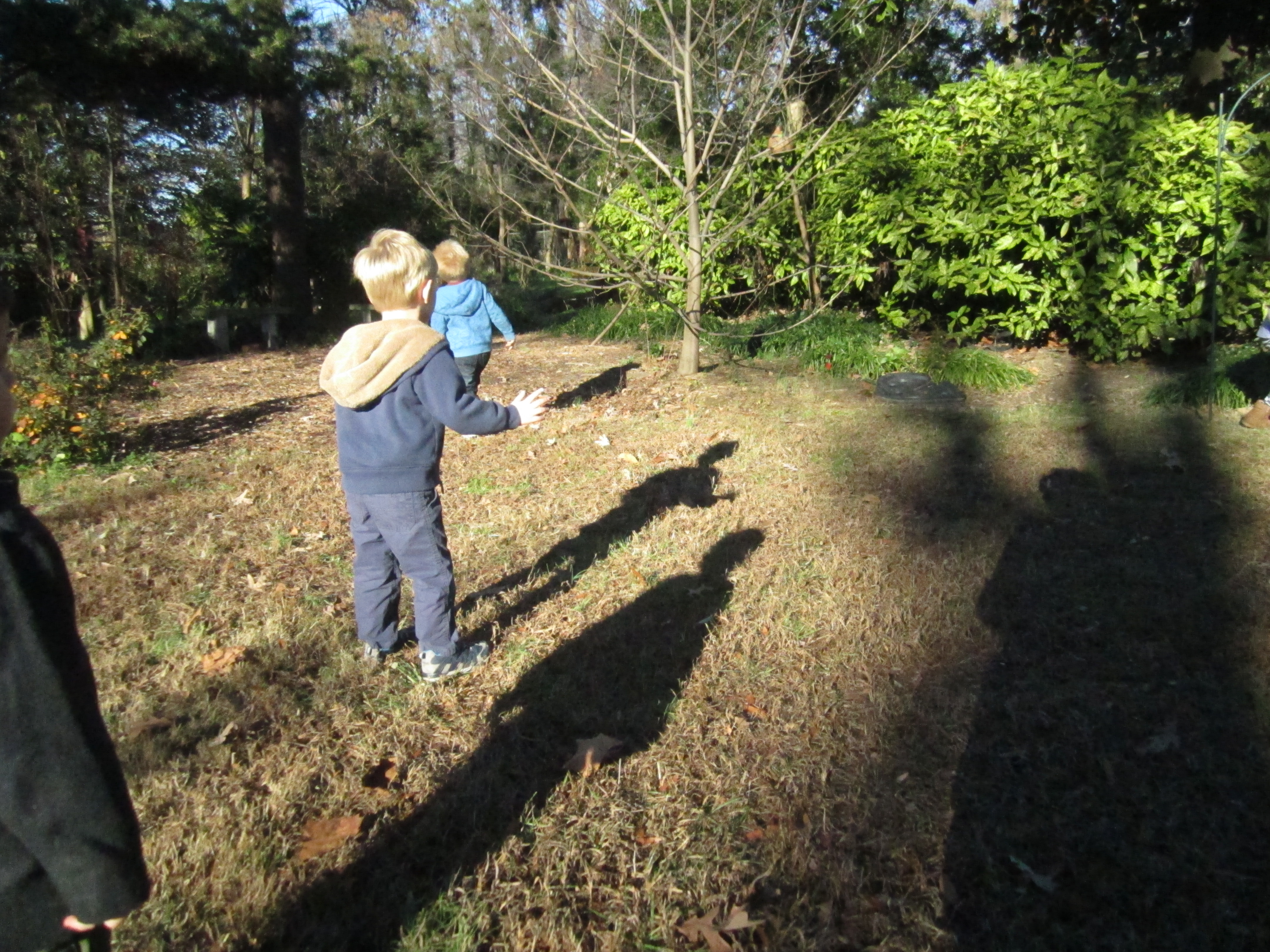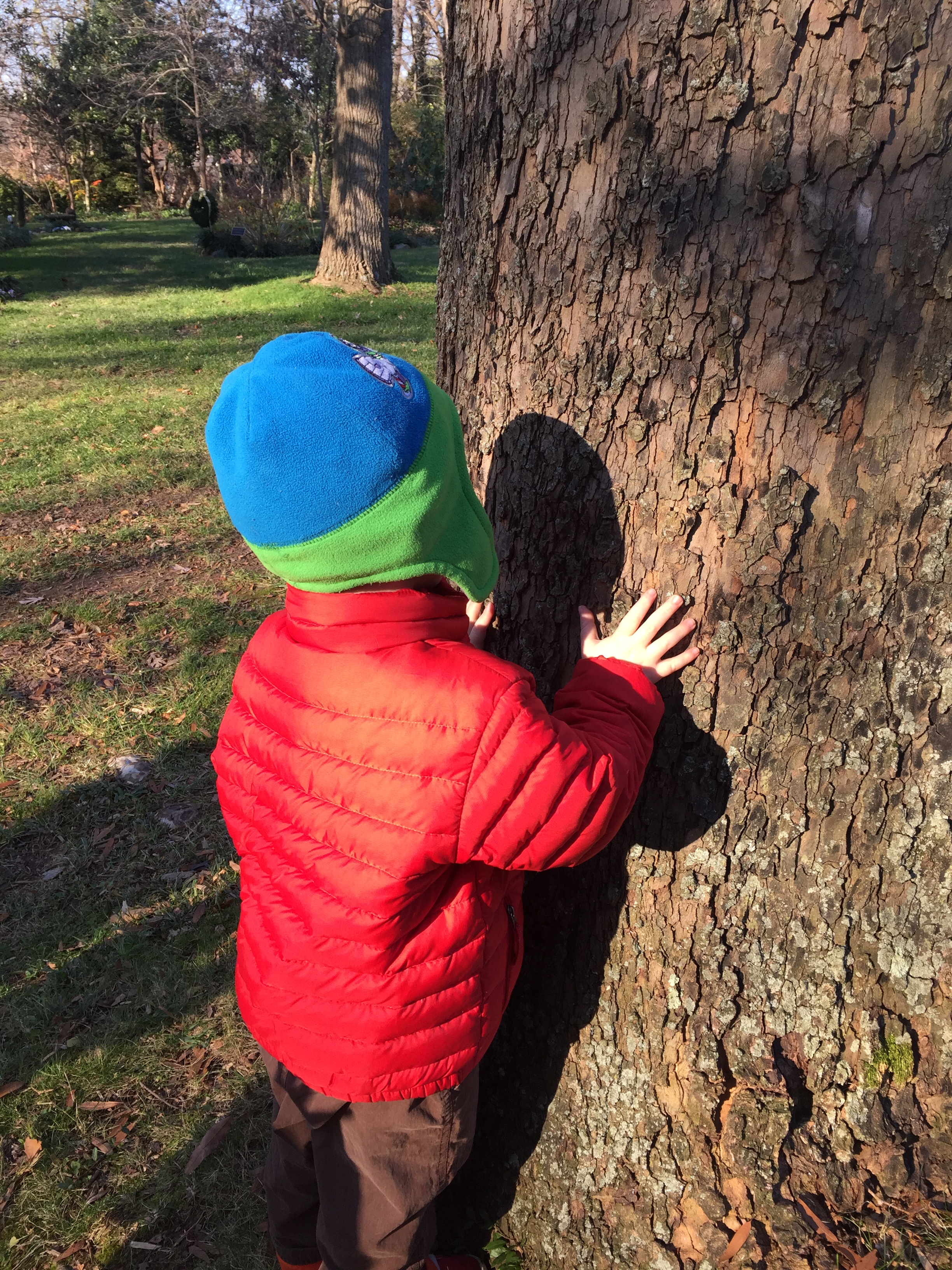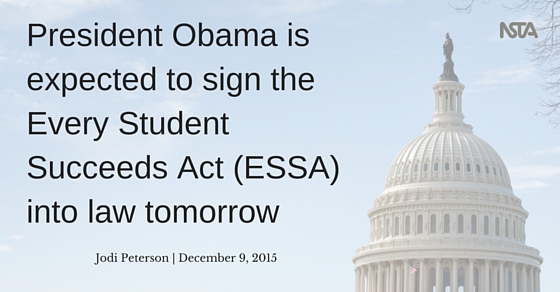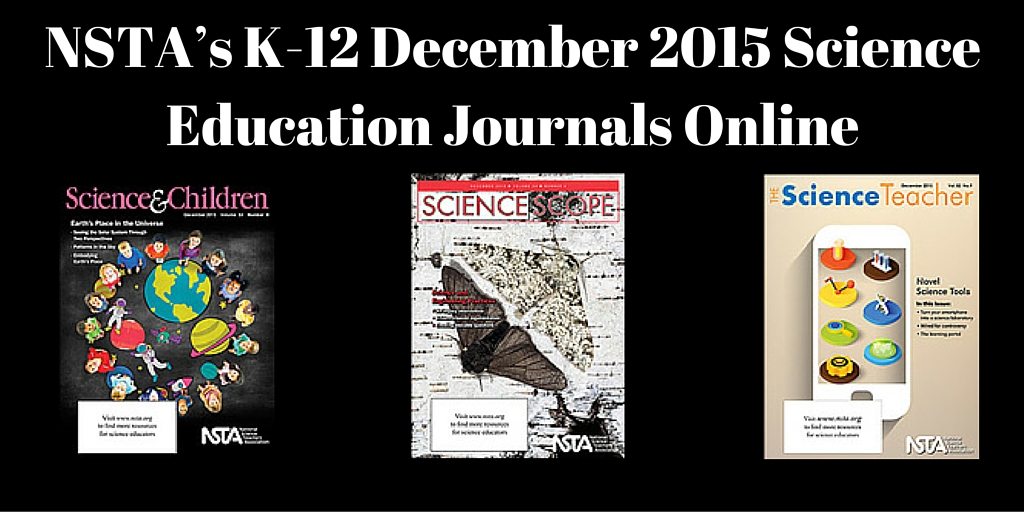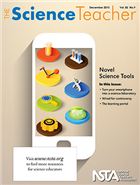Education Gets $1.2 Billion Increase in FY16 Omnibus
By Jodi Peterson
Posted on 2015-12-17
Earlier this week the House Appropriations Committee released the FY 2016 Omnibus Appropriations bill, which provides for discretionary funding for the federal government through the end of the fiscal year, September 30, 2016.
The bill funds the Department of Education at $68 billion, a $1.2 billion increase above the fiscal year 2015 level.
Although the program was not reauthorized in the Every Student Succeeds Act, FY16 funding for the Math and Science Partnerships was $152,717,000. Title II Teacher Quality grants were funded at $2,349,830,000 and 21st Century Community Learning Centers were funded at 1,166,673,000. Congress did not provide funding for Next Generation High Schools, a new program heavily promoted by the Obama Administration.
Title I grants to local school districts received $14.9 billion, an increase of $500 million above the 2015 level. Funding for the Individuals with Disabilities Education Act would increase by $415 million, to $11.9 billion total. See the chart of funding for FY2016 STEM federal programs.
A tax proposal would extend the teacher tax credit that allows teachers to deduct out-of-pocket classroom expenses through the end of 2016, and adjust the $250 tax credit for inflation in future years.
Overall funding for the science agencies was very positive this year. The National Science Foundation saw a modest 1.6 percent funding increase, up $119.3 million for a total budget of $7.46 billion for FY2016. NSF’s education programs received $880 million, a $14 million increase from last year. STEM+C Computer Science Partnerships Program was level funded at $57 million.
NASA saw a 7.1% increase in funding, the NOAA increase was 5.8 %, and the increase for funding for the National Institutes of Standards and Technology (NIST) was 11.6 %. The Department of Energy Office of Science received a 5.5 % increase, while funding for the DOD Science and Technology will increase 8.2%.
The House of Representatives is expected to vote on the funding package this Friday, December 18, with a Senate vote shortly thereafter. The government is currently being funded with a short term stop gap funding resolution that will expire on December 22.
What’s Next for the Every Student Succeeds Act?
What’s ahead for the new federal education law, the Every Student Succeeds Act, now that the president has signed the bill into law?
States and schools will have to transition to the new law from No Child Left Behind. The waivers to NCLB provided to states will be void by August 1, 2016, and the new federal law is expected to be in place beginning in the 2017-18 school year. Some issues in the new law will require the Department to do negotiated rulemaking, a process where representatives from the Department of Education and members from the education community meet to negotiate the terms of the new law.
Education Secretary Arne Duncan said the Department will send out guidance to states on the new law and next steps for implementation soon.
Jodi Peterson is Assistant Executive Director of Legislative Affairs for the National Science Teachers Association (NSTA) and Chair of the STEM Education Coalition. e-mail Peterson at jpeterson@nsta.org; follow her on Twitter at @stemedadvocate.
The mission of NSTA is to promote excellence and innovation in science teaching and learning for all.
Follow NSTA
Constructivist theory and its use in the Next Generation Science Standards
By Robert Yager
Posted on 2015-12-17
The people involved with the Next Generation Science Standards (NGSS) have indicated that they did not plan to “mess” with teaching goals, professional development of teachers, and the ways teachers teach which were used as headings in the 1996 National Science Education Standards (NSES). But the National Governors Association has called for improving “training” of teachers — but many professionals find the word “training” of teachers as an example of failure to indicate any teachers and their teaching as “professional.” The report focuses on career pathways without adequate evidence for achieving the reforms; nor does it suggest the need for collaboration for teachers, administrators, parents, and community leaders. Perhaps, more is needed in the New Standards than merely STEM (Science, Technology, Engineering, and Mathematics) efforts as the heart of the outline for the NGSS for all to use in 2016 and beyond?
When the NSES (1996) was released, it indicated four goals for school science to produce students who: 1) experience the richness and excitement of knowing about and understanding the natural world; 2) use of appropriate science processes and principles in making personal decisions; 3) engage in public discourse and debate about matters of scientific and technological concern; and 4) increase their economic productivity in their use of the knowledge, understandings, and skills of scientifically literate persons concerning their careers.
The teaching section of the Standards began with major ways science teaching should improve. The advocated changes were the easiest to assess and to develop (with little debate or objections). These Standards said there should be less emphasis in teaching of the following: 1) treating all students alike and responding to the group as a whole; 2) rigidly following curriculum; 3) focusing on student acquisition of information; 4) presenting scientific knowledge guided by lectures, texts, and demonstrations; 5) asking for recitation of acquired knowledge; 6) testing students regarding factual information at the end of the unit or chapter; 7) maintaining teacher responsibility and authority; 8) supporting competition; and 9) working alone.
Conversely, the Standards called for more emphasis on the following:
1) understanding and responding to student interests, strengths, experiences, and needs; 2) selecting and adapting curriculum; 3) focusing on student understanding and use of scientific knowledge, ideas, and inquiry processes; 4) guiding students in active and extended scientific inquiries; 5) providing opportunities for discussion and debates among students; 6) continuously assessing student understanding (and involving students in the process); 7) sharing responsibilities for learning with students; 8) supporting a classroom community via cooperation, shared responsibilities, and respect; and 9) working with other teachers to enhance the school science program.
Interestingly, there has been little progress to increase emphasis of these nine conditions. And unfortunately, the items that the NSES said be emphasized less remain largely unchanged with respect to the changes advocated. The Governors Association report does not seem to help with the reforms and the actual changes needed in teaching for the reforms to succeed. They ignore the Wiggins and McTighe’s recommendations for “Backward Design.” The stages in the Backward Design process are: identify desired results, determine acceptable evidence, and do both before planning learning experiences and lesson planning.
It has been 50 years since Vygotsky offered the Constructivist Learning Theory. It essentially encouraged students to construct their own interpretations of actions as they explored the environment they are in and offer their own ideas for explaining the objects and events encountered. The constructivist practices have been described as: 1) posing problems of emerging relevance to learners; 2) structuring learning around “big ideas” or primary concepts; 3) seeking and valuing varied student points of view; 4) adapting curriculum to address student involvement; and 5) assessing student learning in the context of reform teaching.
Constructivist theory influenced Carl Sagan’s statement that all humans start out as scientists who are curious, seek explanations, collaborate with others concerning questions and ideas about their current and daily lives. Constructivist practices encourage all to explore the explanations that are offered by others and encourage all to collect evidence for supporting their explanations. Yet K-12 students of science seldom accomplish better understanding of the universe. How can we get more practitioners involved in correcting the real problems with school science?
Robert E. Yager
Professor of Science Education
University of Iowa
The people involved with the Next Generation Science Standards (NGSS) have indicated that they did not plan to “mess” with teaching goals, professional development of teachers, and the ways teachers teach which were used as headings in the 1996 National Science Education Standards (NSES).
Did They Really Read It?
By sstuckey
Posted on 2015-12-16
[youtube]https://youtu.be/ThHYGzvrxZ0[/youtube]
In this video, columnist Jared Mader shares information from the Science 2.0 column, “Did They Really Read It?” that appeared in a recent issue of The Science Teacher. Read the article here.
[youtube]https://youtu.be/ThHYGzvrxZ0[/youtube]
In this video, columnist Jared Mader shares information from the Science 2.0 column, “Did They Really Read It?” that appeared in a recent issue of The Science Teacher. Read the article here.
Shadow formation and natural or electric light
By Peggy Ashbrook
Posted on 2015-12-15
At mid-December the children’s morning shadows are recognizably long. Over time, through repeated observations made formally or just in casual comments, children begin to notice that the position of the sun in the sky changes during the day. Kindergartners may notice that the sun also changes position during the year, depending on how often they are able to be outside and have a conversation about the sun’s location.
When young children begin to explore shadow formation they don’t understand the relationship between the light source and shadows. It’s interesting to see them realize that they have to place their body in the light from a source to create a shadow. Understanding that their body blocks the light comes even later.
 Challenge children to make a shadow “bigger” or “smaller,” and “longer” or “shorter,” as they play with a flashlight. By describing both a flashlight and the sun as “light sources” we help children make connections between the movement of a flashlight and the movement of the sun—movement that changes the shape and position of shadows.
Challenge children to make a shadow “bigger” or “smaller,” and “longer” or “shorter,” as they play with a flashlight. By describing both a flashlight and the sun as “light sources” we help children make connections between the movement of a flashlight and the movement of the sun—movement that changes the shape and position of shadows.
At mid-December the children’s morning shadows are recognizably long. Over time, through repeated observations made formally or just in casual comments, children begin to notice that the position of the sun in the sky changes during the day. Kindergartners may notice that the sun also changes position during the year, depending on how often they are able to be outside and have a conversation about the sun’s location.
The Paris Agreement: What Do Science Teachers Need to Know for Class on Monday?
By Lauren Jonas, NSTA Assistant Executive Director
Posted on 2015-12-12
The Paris Climate agreement is top news this weekend. Here are a few resources teachers can share with their students on Monday.
Share this tweet
Seeing the Earth from 250 miles up gives you a new appreciation for why we need to take care of it. #ParisAgreement pic.twitter.com/mGPdUKRRi7
— Mark Kelly (@ShuttleCDRKelly) December 12, 2015
Breaking from Nature News: Nations approve historic global climate accord. Agreement forged in Paris aims to hold warming “well below” 2°C.
Watch as the President Delivers a Statement on the Paris Climate Agreement
Read the New York Times article “Nations Approve Landmark Climate Accord in Paris.” This article gives a nice summary, starting with “representatives of 195 countries reached a landmark climate accord that will, for the first time, commit nearly every country to lowering planet-warming greenhouse gas emissions to help stave off the most drastic effects of climate change.”
Find the source document from the United Nations: Adoption of the Paris Agreement
Glance at the key points, from the Guardian. “The goal of 1.5C is a big leap below the 2C agreed six years ago in Copenhagen. Here’s what the agreement means for global emissions and the future of the planet.”
Get more from NSTA at our special focus site on Climate Science Resources.
The mission of NSTA is to promote excellence and innovation in science teaching and learning for all.
Follow NSTA
The Paris Climate agreement is top news this weekend. Here are a few resources teachers can share with their students on Monday.
Share this tweet
Seeing the Earth from 250 miles up gives you a new appreciation for why we need to take care of it. #ParisAgreement pic.twitter.com/mGPdUKRRi7
Teacher-leaders
By Mary Bigelow
Posted on 2015-12-11
 My principal tells me I have “leadership potential.” I’ve been teaching Earth science for 11 years. I like my students and I feel confident with the curriculum. I don’t want to leave the classroom, but a little voice keeps whispering that she may be right. Should I try something new? —B., New York
My principal tells me I have “leadership potential.” I’ve been teaching Earth science for 11 years. I like my students and I feel confident with the curriculum. I don’t want to leave the classroom, but a little voice keeps whispering that she may be right. Should I try something new? —B., New York
What a vote of confidence from your principal! She must see something in you that can and should be shared with others. I can understand your hesitation to move to an administrative position, just as you have developed a repertoire of teaching strategies and a good rapport with students. But after 11 years you might be ready for new and challenging opportunities, in or out of the classroom.
I would listen to your little voice and look into your state’s requirements to earn credentials as a supervisor, principal, or curriculum specialist. In an administrative position, your insights and experience would make you a valuable resource for the science faculty. You would have first-hand experience with a teacher’s responsibility for safety in the labs and security in the storage areas. You would know how much behind-the-scenes work science teachers do, and you would be aware of the hazards (and possible liabilities) of scheduling non-science classes or study halls in lab classrooms. Working with a principal or curriculum director who understands the Next Generation Science Standards (NGSS) and the unique demands of science instruction would be a dream come true for many teachers.
Even if you work toward the credentials, it doesn’t mean you have to become a principal or central office administrator. The coursework, reflective processes, and internship can give you a big-picture look at schools as part of a system and how science education fits into school-wide issues and initiatives (I found the school law courses to be eye-opening). Having administrative credentials can open the door for other opportunities, too.
On the other hand, if you’re not ready for more coursework, perhaps becoming a “teacher-leader” would be a better option.
This includes a variety of roles within the school or district: an advocate for science on school committees and task forces, department chairperson, instructional coach, mentor for new or struggling teachers, advisory board member, grantwriter, team leader, or project director. You could get involved with curriculum development, conduct action research, pilot new technologies, or attend/present at school board meetings. These opportunities for teacher-leadership would not require leaving the classroom.
Professional development is another arena for teacher-leaders. You could offer workshops for teachers in your district or others. (A district I worked in used teacher leaders to do most of the summer academy sessions.) Or check with a regional service agency or informal science organization to see if they need workshop presenters or advisors. Consider sharing your experiences and expertise by writing articles for NSTA journals or presenting at conferences, too. It’s inspiring for others to hear from real practitioners.
Networking is an important part of being a teacher-leader, and social media provides many ways to work with and learn from our colleagues (for example, participating in NSTA’s discussion forums and e-mail lists, communicating with other teacher-leaders through Facebook, or participating in chats on Twitter)
As a potential teacher-leader or administrator, don’t underestimate the value of your contributions. I’m sure you have the skills and knowledge, as well as a passion for science, which will enable you to be a valuable resource not only to your students, but also to your school and to the profession. And it sounds like you already have a mentor for the process.
Senate Passes ESSA, President Obama to Sign Bill into Law Tomorrow, Dec. 10
By Jodi Peterson
Posted on 2015-12-09
On Weds. Dec. 9, the Senate approved the bill to reauthorize No Child Left Behind by a vote of 85 to 12, and President Obama is expected to sign the Every Student Succeeds Act (ESSA) into law tomorrow, ending the seven year effort to replace the widely unpopular 2002 federal education statute with a new law that provides much more power back to the states and local districts.
The 12 Senators voting against the bill were Sens. Roy Blunt (MO), Mike Crapo (ID), Steve Daines (MT), Jeff Flake (AZ), Mike Lee (UT), Jerry Moran (KS) , Rand Paul (KY), James Risch (ID), Ben Sasse (NE), Tim Scott (SC), Richard Shelby (AL) and David Vitter (LA). The three presidential candidates, Sens. Cruz, Rubio and Sanders, did not vote.
Last week, the House passed the bill by a vote of 369 to 64 on Wednesday, December 2, to approve the Every Student Succeeds Act.
The ESSA consolidates a number of programs (including the Math and Science Partnership) into a block grant to the states. Although it maintains the federal rule on testing (once every year in grades 3-8 for ELA and math and three times in science), the new law provide more opportunities for districts and states to develop and provide STEM opportunities to students and professional learning to teachers.
For background information on the bill to reauthorize No Child Left Behind and the Every Student Succeeds Act (ESSA) please read this blog.
Jodi Peterson is Assistant Executive Director of Legislative Affairs for the National Science Teachers Association (NSTA) and Chair of the STEM Education Coalition. e-mail Peterson at jpeterson@nsta.org; follow her on Twitter at @stemedadvocate.
The mission of NSTA is to promote excellence and innovation in science teaching and learning for all.
Follow NSTA
NSTA’s K-12 December 2015 Science Education Journals Online
By Korei Martin
Posted on 2015-12-09
Want to give your students a sense of the Earth’s place in the universe? Wondering how you can strengthen your students’ grasp of science and engineering concepts? Curious about how today’s technology can assist you in teaching? The December K–12 journals from the National Science Teachers Association (NSTA) have the answers you need. Written by science teachers for science teachers, these peer-reviewed journals are targeted to your teaching level and are packed with lesson plans, expert advice, and ideas for using whatever time/space you have available. Browse the December issues; they are online (see below), in members’ mailboxes, and ready to inspire teachers!
As scientists continue to investigate other planets and solar systems, understanding the universe has become increasingly important. This issue of S&C offers ways to help you deepen your students’ interest in Earth’s place in the universe.
Featured articles (please note, only those marked “free” are available to nonmembers without a fee):
- Adapt or Discard?
- Free – Editor’s Note: Earth’s Place in the Universe—Understanding Develops Over Time
- Free – Embodying Earth’s Place in the Solar System
- Fossil Explorers
- Map That Find!
- Patterns in the Sky
- Seeing the Solar System Through Two Perspectives
- Table of Contents
Having students construct an evidence-supported explanation of why an insect’s coloring might affect its population size is just one way to assess their mastery of specific science practices. You’ll find other strategies for assessing and strengthening students’ grasp of science and engineering practices inside this issue of Science Scope.
Featured articles (please note, only those marked “free” are available to nonmembers without a fee):
- Argumentation and Explanation: Tools for Using Them Together While Keeping Them Separate
- Assessing Science Practices: Moving Your Class Along a Continuum
- Authentic Science Investigation in the Classroom: Tools for Creating Original, Testable Questions and Graphical Hypotheses
- Free – Editor’s Roundtable: The End of the Grand Parade
- Free – My Journey to Understand and Implement the NGSS
- Present, Critique, Reflect, and Refine
- The ICAN Intervention: Helping Science Learners Make Connections to Content During Inquiry
- Table of Contents
In the classic 1980s Back to the Future films, the imagined world of 2015 contained an array of fantastic new technologies, from flying cars and hovering skateboards to flat panel televisions and video chat systems. We don’t yet have flying cars or hoverboards, but if the films’ characters could have time-traveled to a real 2015 science classroom, they would have been amazed by the technologies actually available to today’s teachers, tools unimaginable 30 years—or even a decade—ago. This issue describes some of these new technologies: GIS mapping tools to plot bird diversity, digital probeware to study the greenhouse effect, online simulations to investigate DNA and energy, and even cell phones as digital sensors to explore Newton’s laws of motion.
Featured articles (please note, only those marked “free” are available to nonmembers without a fee):
- Clearing the Air
- Climbing the NGSS Mountain
- Free – Editor’s Corner: The Future Is Now
- The Learning Portal
- Turn Your Smartphone Into a Science Laboratory
- Where the Birds Live
- Free – Wired for Controversy
- Table of Contents
Get these journals in your mailbox as well as your inbox—become an NSTA member!
The mission of NSTA is to promote excellence and innovation in science teaching and learning for all.
Follow NSTA
House Passes New Education Law, Senate Action Expected Week of Dec. 7
By Jodi Peterson
Posted on 2015-12-07
The U.S. House of Representatives voted 369 to 64 late on Wednesday, December 2, to approve the Every Student Succeeds Act (ESSA), the federal education law which will replace the No Child Left Behind (NCLB) Act. We anticipate the bill will go to the Senate for approval sometime the week of Dec. 7. President Obama is expected to sign the bill into law by year end.
NSTA has endorsed the bill, as noted in this Education Week article.
The bill was also endorsed by most, if not all, of the education and civil rights groups. A big endorsement from the National Governors Association (NGA) and a Wall Street Journal article helped to solidify Republican support in the House. (In their statement the NGA noted that ESSA endorsement “marks the first time that the National Governors Association has endorsed federal legislation since welfare reform in 1996.” The Wall Street Journal noted the bill “isn’t perfect but would represent the largest devolution of federal control to the states in a quarter-century. It’s far better than the status quo that would continue if nothing passes.”)
After the House vote on Dec. 2 Secretary of Education Arne Duncan and the White House praised legislators for passing the bill. In a statement the White House said “The bill rejects the overuse of standardized tests and one-size-fits-all mandates on our schools, ensures that our education system will prepare every child to graduate from high school ready for college and careers, and provides more children access to high-quality state preschool programs.” They called on the Senate to act this week.
Read more about the STEM education provisions in ESSA.
Here are some key highlights in the new bill.
- The new bill eliminates the NCLB highly qualified teacher requirement. States are no longer required by the federal government to do teacher evaluations using student outcomes.
- A $1.6 billion block grant (Title II) consolidates a number of programs, including the Math and Science Partnership program. However there are funding opportunities for STEM teacher professional development, leadership training, grants for performance pay and differential pay, and alternative cert programs throughout the bill in both Title II and Title IV available to both states and districts (more on that here).
- Adequate Yearly Progress AYP is gone. States would test students in reading and math in grades 3 through 8 and once in high school and continue to report on data for the schools and the subgroups of students (such as ELL students, special education students, low income, and minorities). Science testing would continue in the bill, once in elementary grades, once in middle level, and once at high school (similar to current law)
- States would decide what to hold schools and districts accountable for and how to intervene in low performing schools. They must use test scores in accountability frameworks, but also must include multiple measures. States are required to identify and intervene in schools with the bottom 5 percent of performers and intervene in high schools where the graduation rate is 67 percent or less.
- States must adopt “challenging” academic standards. The bill restricts the powers of the Secretary of Education and specifically prohibits the U.S. Secretary of Education from incentivizing, forcing, or coercing states into adopting Common Core, or interfering with a state’s right to develop or change its own set of standards and assessments.
- States to create their own testing opt-out laws but it must maintain the 95 percent student participation federal requirement.
Read the bill here.
Read the Education Week article on the bill here.
There will be more to come on the new federal education law in weeks ahead as we take a deep dive into the 1000-plus-page bill.
Jodi Peterson is Assistant Executive Director of Legislative Affairs for the National Science Teachers Association (NSTA) and Chair of the STEM Education Coalition. e-mail Jodi at jpeterson@nsta.org; follow her on Twitter at @stemedadvocate.
The mission of NSTA is to promote excellence and innovation in science teaching and learning for all.
Follow NSTA
17 Things You'd Only Hear if You Were at #NSTA15 in Kansas City Last Week
By Lauren Jonas, NSTA Assistant Executive Director
Posted on 2015-12-06
They come to conferences for intensive professional learning, nationally renowned speakers, and exhibit hall swag… but what science teachers really come to NSTA for are the moments you wouldn’t get anywhere else!
#1 …today I lassoed a beetle
#wcedchat #NSTA15 #carolinaredcarpet Today I lassoed a beetle and it pulled things.Who doesn’t like science again?? pic.twitter.com/fYJ33al24f
— Kayla Howard (@kaycards) December 3, 2015
#2 … the moment when you buy pangea cookie cutters from a Super Bowl champ
The moment when you buy a pangea cookie cutters from a Super Bowl champ. #NSTA15 pic.twitter.com/wM1gz2Zadk
— Kara Luce (@karalu79) December 4, 2015
#3 …I’m learning about the zombie apocalypse
While I’m not with my kids today I’m learning about the zombie apocalypse at #NSTA15 #12daystwitter pic.twitter.com/Y86MtYgiR7
— Candace Johnson (@MsJ_Tigers) December 4, 2015
#4 …it’s a spleen!
Hey #RoomE102…look what I brought home from #nsta15 today! IT’S A SPLEEN! #SmileWhenYouSayThat pic.twitter.com/XAeCZj9Cvu
— Eric Magette (@mistermagette) December 4, 2015
#5 …are you just bartling puzballs?
Do you REALLY understand the concept or are you just “bartling puzballs”? https://t.co/X4oZjB2xc4 @CTSKeeley #NSTA15 pic.twitter.com/X9lMw1OjcG
— Ryan Lacson (@noscals) December 3, 2015
#6 …I made a butterfly necklace today!
I made a butterfly necklace today! #NSTA15 pic.twitter.com/dfJn5TK5Fd
— Bonnie Stafford (@6thScienceTeach) December 3, 2015
#7 …STEMstars are popping up everywhere
#STEMstars are popping up everywhere here at #NSTA15 KC! pic.twitter.com/CX0WXsAnDj
— NatSciTeachAssoc (@NSTA) December 3, 2015
#8 …received 2 dogfish sharks
Received 2 dogfish sharks at #NSTA15 conv @madjane100 guess what we get to do #emwolves pic.twitter.com/WMTdpcOPJE
— Lorie Sliefert (@lsliefert) December 3, 2015
#9 …just made poop!
#NSTA15 thanks @NSTA for teaching us about the digestive system pic.twitter.com/38FSuwEbx2
— Christi Schumaker (@cschumaker1) December 3, 2015
#10 …your phone lets you see infrared
Selfie mode on your phone lets you see infrared! #nsta15 pic.twitter.com/GEaJYmWNI0
— Ms West (@MsWest415) December 4, 2015
#11 …I constructed a wind turbine
Coach Hall and I constructed a wind turbine & made electricity while representing @CotterWarriors at #NSTA15! pic.twitter.com/yE9ucA3e8P
— LaDonna Mendleski (@LDM_Teach) December 3, 2015
#12 …so many people who love science
Great to hang out with so many people who love science! Thanks @cindymagnifico for setting this up! #NSTA15 pic.twitter.com/3Dsa0SYPgk
— Dave Nowak (@dnowak77) December 3, 2015
#13 …wouldn’t be an NSTA conference without a shelfie
Wouldn’t be an NSTA conference without a shellfie. Yes. That was intentional. #NSTA15 pic.twitter.com/ho5cOX4ggT
— Robert Starr (@A_smarter_Starr) December 4, 2015
< /p>
#14 …ask the local police department for electronic balances they have from drug busts
#NSTA15 learning to ask the local police department for electronic balances they have from drug busts #sciencerocks pic.twitter.com/OwDRd9OaSf
— Mrs. Wangeman (@ChemLes) December 4, 2015
#15 …the spaghetti marshmallow challenge is on!
The #SpaghettiMarshmallowChallenge is on! @AAPTHQ #NSTA15 #STEM #engineering pic.twitter.com/tAbaplnb9k
— Steve Maier (@SteveMaier_) December 4, 2015
#16 …we are superheroes
We are superheroes! #NSTA15 #FischerScientific #LHS #IrishPride pic.twitter.com/ZBY2cm7BAr
— Elizabeth J Jones (@Elisamaj) December 4, 2015
#17 …first session this morning gave me a lesson idea for Monday!
First session this morning gave me a lesson idea for Monday! Cant wait! #NSTA15
— Sarah Samuelson (@SciSarahSam) December 5, 2015
They come to conferences for intensive professional learning, nationally renowned speakers, and exhibit hall swag… but what science teachers really come to NSTA for are the moments you wouldn’t get anywhere else!


